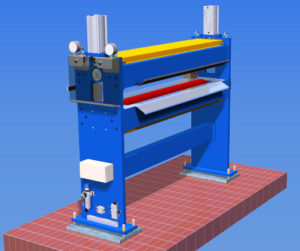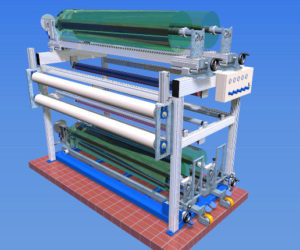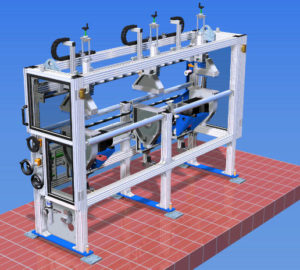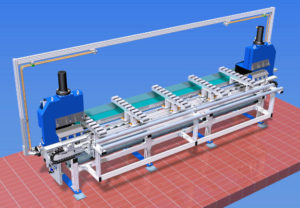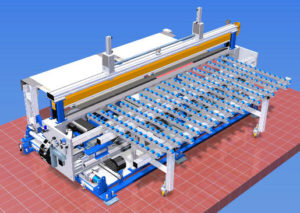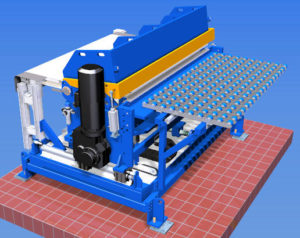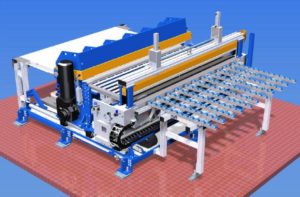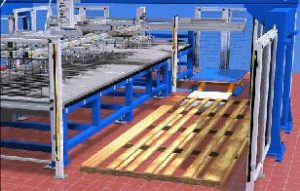Calender GW
Mechanical structure
- Solid machine stand with cross-bracing, onto which the guide rails for the roller bearings are screwed The centre roller is rigidly fastened to the machine stand. The upper and lower rollers on the other hand can be hydraulically driven vertically against stops. The line pressure critical for the production, is created through hydraulic cylinders. The driving together of the rollers is prevented by corresponding thrust rings, which prevent the surface of the roller being damaged when “driving” with a negative roller gap. The necessary hydraulic power unit is integrated into the machine stand. The line pressure for the upper and lower rollers can be adjusted separately
- Mounting of the three rollers in separate bearing blocks, so that the replacement of the rollers can be implemented with minimal effort.
- The calender is mechanically and electrical prepared for the connection of a pre-cooling unit.
AZM pull-off roller
Mechanical structure
- Lower pull-off roller operated via servo-bevel gear motor, pneumatically lifted upper pull-off roller (not motorised).
- Drive motors available in different power levels.
- In case of multiple pull-off rollers, the upper rollers may be activated individually.
- In case of multiple pull-off rollers, a support block is also included in Addition to the base plates, which also transfers the pull-off force to the floor.
- The rollers are supported by high-performance bearings.
FO plate film applicator
Mechanical structure
- Film application station for attaching the film rolls including axis. For film stations designed for applying film underneath the product track, a pull-out mechanism is used for the station so that the film roll may be inserted without any problems.
- To tension the film to the side, the film is guided from the film application station via a spreading roller to the product track. The spreader roller tensions the film perpendicular to the extrusion axis on both sides, which therefore prevents wrinkle formation.
- The film applicators can be designed for processing just one side of the product track or both sides. In case multiple film applicator stations are used, one of the respective stations may be fitted while the second is being used. This shortens the time for changing the film roll and prevents generation of scrap material at the plate extrudate.
RBU/RBF edge trimming
Mechanical structure
- Depending on the design, the edge trimming saw may be equipped with between 2 and 5 saw units. Depending on the number, the Units are arranged partially beside each other and partially behind each other (in the extrusion direction). Accordingly, this results in the machine’s total length.
- The saw motors are designed as flat motors in various power levels.
- Saw guards designed for high chip extraction underneath and extraction boxes above the product track. The top suction boxes are lowered vertically onto the product track when a saw unit is activated.
- Saw unit transverse movement via trapezoidal threaded spindles and hand wheels.
- Support adjustment for common adjustment of external saw units.
ZH/ZE trim strip chopper
Mechanical structure
- Cutting unit transverse movement to work position via trapezoidal threaded spindle and hand wheel.
- Pneumatic analogous movement of the cutting units during cutting.
- For ZH: Cutting force directly via upper cutting blade moved by hydraulic cylinders against a fixed lower cutting blade.
- For ZE: The cutting force is transferred via a gear motor and eccentric lever to the upper cutting blade.
- Trim strips are guided via the swivelling guide units into the cutting units.
QTS cross-cutting saw
Mechanical structure
- Synchronous movement with the extrusion material via trapezoidal threaded spindle, servo motor, and special parallel running controls.
- The drive of the saw slide is aligned in the cutting direction above a dust-protected, closed ball screw and servo motor.
- Saw guard designed for high chip extraction below and Extractor beam above the product track. Extractor hoses guided via corresponding energy chain.
- Top extractor beam simultaneously laid out as a clamping beam to fasten the product track.
- Removal of the cut plates via an extremely durable transport belt featuring automatic compensation of the analogous movement.
- Saw motor designed as a servo motor in various power levels.
QSS transverse separating cutter
Mechanical structure
- Synchronous movement with the extrusion material via trapezoidal threaded spindle, servo motor, and special parallel running controls.
- Plate shear design as swing-beam plate shears.
- Cut gap setting possible in 4 stages (0.02 to 0.3 mm).
- Upper and lower blades featuring same design. The knives can be rotated once and installed again before they need to be reground.
- Cut movement drive via asynchronous servo motor. In case of extremely high cutting forces, two synchronously operating motors are installed.
- Material clamping via clamping beams that move synchronously with the upper blade beams. The clamping force is regulated pneumatically.
- Removal of the cut plates via an extremely durable transport belt featuring automatic compensation of the analogous movement.
QTK traverse-cutting combination
Basic mechanical layout
- Shared longitudinal slide for both cutting units.
- Sychronous movement with the extrusion material via trapezoidal threaded spindle, servo motor, and special parallel running controls.
- The drive of the saw slide is aligned in the cutting direction above a dust-protected, closed ball screw and servo motor.
- Saw guard designed for high chip extraction below and extractor beam above the product track. Extractor hoses guided via corresponding energy chain.
- Top extractor beam simultaneously laid out as a clamping beam to fasten the product track.
- Motorised intermediate roller track for bridging over the gap between the saw and shearing unit.
- Removal of the cut plates via an extremely durable transport belt featuring automatic compensation of the analogous movement.
- Saw motor designed as a flat motor in various power levels.
- Plate shear design as swing-beam plate shears.
- Cut gap setting possible in 4 stages (0.02 to 0.3 mm).
- Upper and lower blades featuring same design. The knives can be rotated once and installed again before they need to be reground.
- Cut movement drive via asynchronous servo motor. In case of extremely high cutting forces, two synchronously operating motors are installed.
- Material clamping via clamping beams that move synchronously with the upper blade beams. The clamping force is regulated pneumatically.
Hxx plate stacking machine
Basic mechanical layout
- Belt or roller tables are used to transport cut production plates into the plate stacking machine. Depending on the application, these are made of aluminium profiles or welded hollow steel profiles. The belts or rollers are laid out according to the product requirements.
- Traverse carriage depending on the application in various designs. Partially aluminium, partially steel construction. All versions equipped with corresponding high-performance guide systems and drive elements.
- The traverse suction beam for accepting production plates using vacuum suction is mainly comprised of aluminium. The number, size, and material of the vacuum suction plates are defined together with the customer according to the production requirements. In case of different packaging for the production plates, multiple work zones may be added. Flat suction systems may also be used in some cases.
- In the stacking area, palettes may be set down directly or pushed into transport carriages. A push-in/push-out System via rails or similar is also possible. It’s basically important to make sure that there are enough stacking areas to enable a palette change. In case of one stacking area only, the palette must be provided within the interval by two production length cuts or palettes that are received during the change must be removed manually. In case of multiple stacking areas, these may be alternated for stacking.


